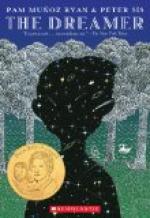At the opposite end of the room a lovely woman in a Chippendale chair was the central figure of a group of ladies and gentlemen each of whom hung upon her least word with an interest amounting to affection. She was a woman who looked like a girl, for thirty years had been kind to her. Glossy brown hair parted in the middle and brushed smoothly down in loops that nearly covered her ears framed an oval face, with delicate, clear-cut features, pale complexion and eyes as brown and melting as a gazelle’s.
She was none other than Mrs. Frances Osgood, the author, or authoress, as she would have styled herself, of “The Poetry of Flowers”—so much admired by her contemporaries—whose husband, Mr. S.S. Osgood, the well known artist, had won her heart while painting her portrait.
Conspicuous in the group of literary lights surrounding her was Dr. Griswold in whose furtive glance, had she been less free from guile, she might have read an admiration fiercer than that of friendship or even of platonic love, and to whose fires she had unwittingly added fuel by expressing admiration for his poems—Mr. Poe’s opinion to the contrary.
Mr. Locke, author of “The Moon Hoax,” was of the group; and the Reverend Ralph Hoyt, who was a poet as well as a preacher; and Mr. Hart, the sculptor; and James Russell Lowell, who happened to be in town for a few days; and Mr. Willis and his new wife; and Mrs. Embury whose volume of verse, “Love’s Token Flowers,” was just out and being warmly praised; and George P. Morris, Willis’s partner in the Mirror, whose “Woodman, Spare that Tree!” and “We were Boys Together,” had (touching a human chord) made him popular.
The beloved physician, Dr. Francis, seemed to be everywhere at once, as he moved about from group to group with a kindly word for everybody—the candle-light falling softly upon his flowing silver locks and his beaming, ruddy countenance.
Suddenly, there was a slight stir in the room—a cessation of talk—a turning toward one point.
“There is Mr. P-P-Poe now,” said Mr. Gillespie to Miss Lynch, and followed her as, with out-stretched hand and cordial smile, she hastened toward the door where stood the trim, erect, black-clad figure of Edgar Poe, with his prominent brow and his big dreamy eyes, and his wife, pale as a snow-drop after her many illnesses, and as lovely as one, and still looking like a child, upon his arm.
Instant pleasure and welcome were written upon every face present save one, and even that quickly assumed a smile as its owner came forward bowing and stooping in an excess of courtesy.
The pair became immediately the centre of attraction. Everybody wanted to have a word with them. It made Virginia thoroughly happy to see “Eddie” appreciated, and she chatted blythely and freshly with all—her spontaneous laugh bearing testimony to her enjoyment—while The Dreamer yielded himself with his wonted modesty and grace to the hour—answering questions as to whether he really did believe in ghosts and whether the experiments in mesmerism in his story, “The Case of M. Valdemar” had any foundation in fact, with his captivating but enigmatic smile, and a little Frenchified shrug of the shoulders.




